#claudia-sur
Explore tagged Tumblr posts
Text
MUCHOS KEDAMONOS SISISISISI 😍😍😍😍😍😍💕
TE QUIERO MUCHO TAMBIÉN AAAA >3<💕💕💕💕💕
TAMBIÉN SUBO SISISI HEHEHEHEHHE 😈









DIBUJOS CON MI AMIGA @momochimchim !
HACE UNOS DIBUJOS TAN PRECIOSOS! 😫💕🛐
AHHAAAHHA LA QUIERO TANTO!💕✨
--------------------------------------------------
Contexto: muchos kedamonos, O ZI O ZI










#collab#my art#chi's art#boony's art#Friends art#Suri's art#kedamono#popee#doctor popee#doctor popee au#keda#junior#popee the performer#chikitos 😭😭💕💕#pepe simp#como amo al Keda de las 80'#😭😭😭💕💕💕#my beloved#claudia-sur
14 notes
·
View notes
Text
Palestine will remain the issue of honorable people only 🇵🇸🍉
400 days of killing children, women and the elderly, destruction, hunger and fear
400 days of living in tents that do not protect against heat or cold
400 days of missiles, bombing and destruction
Save us, world, save my family in Gaza
🙏❤️🩹🍉

@neechees @noble-kale @captainsaltymuyfancy @neptunerings @khanger
@postanagramgenerator @maester-cressen
@doublycharming-tetraquark @claudia-de-lioncourt @claudiaeparvier
@heritageposts @ot3 @ankle-beez @2spirit-Ospoons @dlxxv-vetted-donations
@strangeauthor @socalgal @beserkerjewel @anneemay @feluka
@a-shade-of-blue @determinate-negation
@diasdelasombra @cuntylouis @halalchampagnesocialist
@lamngen @rhubarbspring @heydreamchild @lesbianmaxevans @wellwaterhysteria
@prisonhannibal @finalgirlabigailhobbs @hotgirlmeg
@rosyish @undecimber-of-joy
@maoistyuri @girlinafairytale @foamingatthemeowth @tortiefrancis @turtletoria
@greed-the-dorkalicious @heliopixels @thatdiabolicalfeminist @terezbian @greetings-fiends
@autistickaitovocaloid @bilal-salah @crowlore @wulfums @officialspec
@official-toriel @jestergal @chilewithcarnage @dirhwangdaseul @timetravellingkitty
@septemberlikestea @weirdmarioenemies @brokenbackmountain @toiletpotato @jewfrogs
@opencommunion @maphel-n-doodles @butchmagicalboi @estrellasrojas @beepbatt
@gothclaires @salligora @ignitingthesky @beesmygod @pcktknife
@communistkenobi @mushroomjar @meshmellow @mens-rights-activia @3t22
@sar-soor @mossbawn @murderbot @riding-with-the-wild-hunt @stuckinapril
#free gaza#free palestine#gaza fundraiser#gaza strip#gazaunderattack#gaza genocide#help gaza#palastine genocide#save gaza#stand with gaza#palestine gfm#all eyes on palestine#palestine gofundme#palestine fundraiser#palestinian genocide#support palestine#save palestine#palestine news#i stand with palestine
131 notes
·
View notes
Text
Mentioned a little on twitter earlier about IWTV characters and what element they correspond to but didn't elaborate so I will here and screenshot this post.
Louis - Fire
Maybe this is a little obvious but there is no way it doesn't fit. Beyind his arsonist tendencies (burning down the Theatre Des Vampires, and two other buildings in the book) and Claudia's beginnings and end, Louis has always been tied to fire. He is a very firey sort of character but not in the usual loud, bright sense, in the natural, destructive sense. And it's everywhere in his story. He describes Lestat as his coal fire, when he is made there is fire-the burning pews, he and Lestat dispose of bodies in an incinerator, when he kills the Alderman the rioters start fires, leading to him saving Claudia, "his redemption", from.In s2, one of his first scenes is sitting around a fire, he almost dies by burning twice, once in the Paris sewers and once on stage. It's all fire.
Lestat - Air
Now the most obvious connection here is Lestat's ability to fly, defying and mastering air, but the air goes back even to before Lestat is made a vampire and connects to his desire for freedom. Whether it was the cold, lonely air of Auvergne that he desperately wanted to escape, where he flew off with a troupe of actors only to be dragged back, grounded by his father and brothers; The bustling air of Paris where he finally felt free with Nicki, working in a theatre, free to spread his wings and feel the air, where he also was dragged again through the air to vampirism, then setting free his mother, then the Children of Darkness. Lestat is tied to the air because he is tied to freedom.
Armand - Water
How could Armand be anything but? So old, like water wearing down at a stone, but water has always been his since he was young, mortal. From the oceans and seas beneath the barely remembered boat from his homeland, to Venice, the city of canals he drifted through, fell into, and undeniably many of his first kills as a fledgling came to rest. Then, Rome, Paris, Dubai. All close to water, with rivers or seas or aqueducts so close. He sometimes lingers when boats come in to harbour, he would linger in the shipyard in Venice in his youth. He's always been so close to water, as his identity was as fluid as it, flowing and changing and growing and shrinking, drinking and being drunk from.
Daniel - Earth
Daniel, the mortal boy-reporter turned old man young vampire, the iron-strong link for the vampires to the world they no longer know, the ground they don't recognise beneath their feet. So sur of himself, going everywhere on the globe to find a story because he is the earth listening to it's creations, keeping the most untethered of them grounded. He is a grounding force, challenging Louis' memories, beliefs, embellishments, before coming to concrete truths. That is what makes him fascinating.
#iwtv#tvc#louis de pointe du lac#lestat de lioncourt#armand#amadeo of venice#daniel molloy#meta#amc iwtv#interview with the vampire
61 notes
·
View notes
Text
Something about Louis and the false illusion of choice he always have in his relationships. How everything with Lestat feels wanted by both side and maybe it was but from the start it was always Lestat who wanted Louis and Louis reciprocated with tought of equality in their love but was it really that equal between them?
And there is Armand who offer him a relation where he has the upper hand exept he did not have the upper hand. Armand wanted Louis to want him and he did but the relationship was based on a lie and so was his feelings for Armand.
And finally here is his fascinating boy, the first time no one found him, it was him who found his special boy. And he did not repeat the cycle of love trapped in lie. Louis let the boy leave and he make sur he will be alright giving him the key to believe in what he's capable to do.
I don't say that Louis didn't loved Lestat or Armand but I think his relationship with Daniel was almost as important as the one with Claudia cause he wanted it first and it's the first times he wanted something and was someone outside his relationships.
I love Daniel/Louis in a romantic way but I think the most important thing is their friendship. They are soulmate to me like I ship more devil's minion but I know that if Daniel souls has to meet someone again and again to feel complete it's Louis souls and they are so queer platonic coded to me-
#I have so but so many tought about them#feeling like I'm going to explode#watch me being able to talk only of iwtv for the next month#they drive me insane#iwtv#interview with the vampire#daniel molloy#louis du pointe du lac#danlou#loudaniel#kenshi's fandom
50 notes
·
View notes
Text
Transcript of the French dialogue in IWTV S2 Ep6 - Like the Light by Which God Made the World Before He Made Light
Attack at Madeleine’s shop:
[The song the attackers are singing here is the "Chant des Girondins", which was the short-lived French national anthem under the Second Republic (1848-1852). Here are the lyrics sung in this portion of the show:
"La France appelle ses enfants, – Allons dit le soldat, aux armes ! C’est ma mère, je la défends.
Mourir pour la Patrie"
Which translates to:
"France calls to its children,
- Come, says the soldier, to arms!
She is my mother, so I shall defend her.
To die for the motherland"]
Woman attacker: Bonsoir, Madame Éparvier !
Madeleine: Allez-y ! Faites vos dessins très ingénieux !
Bald attacker: Arrête de les laver et on arrête de revenir, hein !
Woman attacker: On l’a ! On l’a, la pute !... Madeleine est pas bien, elle a attaqué, t’as vu ?... Crie tout ce que tu veux, hein. Tes voisins s’en fichent.
Madeleine: Arrête ! Non !
Bald attacker: On va voir ce qu’elle a donné à l’Allemand !
Madeleine: Tu suces du sang… T’es un v…
Armand and Madeleine discuss her turning:
Armand: Tu aimerais être l’une des nôtres ?
Madeleine: Non, je veux être avec elle. Et toi, tu peux aller te faire foutre.
Armand: They always think they’re different. Stronger. Superior. Jusqu’à ce que la solitude arrive.
Madeleine: Monsieur, ça fait longtemps que je suis toute seule.
Armand: Tu seras un monstre.
Madeleine: Si tu fais de moi un monstre, tu feras que me transformer en ce que je suis déjà.
Armand: Tu vas manger des humains comme tu manges ta pomme ? Un par nuit, aucune pitié pour l’enfant, la mère, l’invalide ?
Madeleine: Je suis un humain et j’aime ma nourriture. Quand je serai un vampire, est-ce que j’aimerai ma nourriture ?
Armand: Comment choisiras-tu qui tuer ?
Madeleine: Je tuerai sur les bords. Les faibles d’abord, et occasionnellement je me livrerai à mes appétits.
Armand: Et quand les derniers vestiges de ton époque auront disparu ? Les voitures, les coiffures, les croyances ? Comment continueras-tu ?
Madeleine: Jeune homme… There’s been a war. Claudia! He thinks there’s something left of my era!... Mais quel con ! [not captioned, but she’s basically calling Armand a dumbass.]
Armand: Comment vas-tu survivre à l’éternité ?
Madeleine: L’homme qui vivait en face… La Gestapo est venue le chercher. On a entendu un coup de feu quand la voiture a tourné au coin de la rue. Et la femme qui habitait plus bas, elle est morte de faim dans sa chambre. Elle portait des vêtements très chics. Elle devenait de plus en plus maigre jusqu’à ce qu’un jour, je regarde par sa porte et elle était là, un squelette dans des vêtements chics. Parfois, je le voyais dans leurs yeux, quand ils étaient sur le point d’abandonner. Et moi, j’ai survécu. Moi, j’ai suivi mes instincts. J’ai trouvé l’amour dont j’avais besoin, même quand c’était un amour dangereux. And I have again.
Armand: Et que feras-tu dans quelques décennies quand elle se jettera dans le feu ? Parce qu’elle le fera.
Madeleine: Peut-être qu’elle le fera pas. T’en sais rien. Peut-être que je suis ce dont elle a besoin pour survivre.
Louis and Armand at the Sacré-Cœur:
Okay, this is a subtle one.
While Loumand kiss on the steps of the Sacré-Cœur, you can hear a man taunting them in the background.
He says: "Hé ! Mais vas-y hé ! Mais suce-le, tant que t’y es ! Sale pédé !"
Which translates to: "Hey! Well go on then! Why don’t you suck him off while you’re at it! Fucking faggots!"
This explains why Louis turns his head around for a second after kissing Armand...
Madeleine’s turning:
Madeleine: J’arrive pas à croire que mon dernier verre de vin soit un Chardonnay. J’aurais dû en prévoir plus.
Madeleine: La pièce tourne…
That's it for this episode! See you in a week for the next one!
Ep. 2 here
Ep. 3 here
Ep. 4 here
#interview with the vampire#iwtv#iwtv season 2#iwtv spoilers#amc interview with the vampire#amc iwtv#french dialogue
47 notes
·
View notes
Text

Icône du cinéma français, Alain Delon s’est éteint ce dimanche 18 août, à 88 ans. De sa révélation sur le grand écran au début des années 1960 à son César du meilleur acteur, retour sur sa carrière en sept films emblématiques qui ont campé son style.
Il était l’un des acteurs qui a enregistré le plus d’entrées en France, totalisant plus de 136 millions de spectateurs avec l’ensemble des films qui l’ont mis en scène. Alain Delon est mort ce dimanche 18 août 2024, à l’âge de 88 ans, ont annoncé ses enfants. La star du grand écran a marqué le cinéma français de son empreinte avec 90 longs-métrages, qui ont façonné sa réputation de légende et son style caractéristique. En voici sept particulièrement marquants.
« Christine » (1958) : sa rencontre avec Romy Schneider Alain Delon n’a que 23 ans et a fait ses premiers pas au cinéma un an plus tôt, dans Quand la femme s’en mêle d’Yves Allégret, lorsque l’actrice allemande Romy Schneider le choisit sur photo pour tourner avec elle dans Christine, de Pierre-Gaspard Huit. Il y incarne le lieutenant Franz Lobheiner, amant d’une riche baronne autrichienne dont il veut rompre, qui tombe follement amoureux de la charmante Christine Weiring, jouée par la jeune star du cinéma qui n’a alors que 20 ans. La première rencontre entre les deux acteurs, à la descente de l’avion, deux mois plus tôt, n’était pourtant pas des plus concluantes. La barrière de la langue les sépare et le duo ne s’entend absolument pas. Ils finiront pourtant par tomber amoureux et former un couple connu comme « les plus beaux fiancés d’Europe ».
« Plein soleil » (1960) : la révélation d’un « jeune premier » Deux ans plus tard, Alain Delon est choisi par le réalisateur René Clément pour jouer dans une adaptation du roman Monsieur Ripley, de Patricia Highsmith. Alors qu’il devait jouer le deuxième rôle masculin, il parvient à convaincre l’équipe de réalisation qu’il serait plus adapté dans le costume du personnage principal, Tom Ripley, qui colle plus à son caractère un peu « voyou ». Avec ce rôle, Alain Delon se révèle sur le grand écran et pose les jalons de ce qui deviendra son style, charismatique et un peu rebelle. « Personne ne savait qui j’étais. Le film qui a fait le tour du monde, a été la base de ma carrière », avait d’ailleurs reconnu l’acteur.
« Le Guépard » (1963) : la palme d’or à Cannes Alain Delon y incarne Tancrède Falconeri, le neveu du prince Fabrice de Salina (Burt Lancaster) qui se lie d’amour avec une bourgeoise, Angelica Sedara (Claudia Cardinale), dans une Italie du milieu du XIXe siècle marquée par le déclin de l’aristocratie traditionnelle. Adapté du roman éponyme de Giuseppe Tomasi di Lampedusa, cette fresque obtient la Palme d’or au Festival de Cannes en 1963 et devient un succès commercial et critique dès sa sortie. Alain Delon, au sommet de son élégance (moustache fine et raie sur le côté), y est l’incarnation de la noblesse. Le couple qu’il forme avec Claudia Cardinale entre dans l’histoire du cinéma. Le film comporte notamment une scène de bal devenue iconique, qui marque la victoire de la bourgeoisie sur la noblesse et où les trajectoires du trio principal trouvent leur aboutissement.
« Le Samouraï » (1967) : la consécration du « genre » Delon Cette première collaboration avec Jean-Pierre Melville donne l’un des chefs-d’œuvre de la filmographie de Delon, qui incarne le tueur solitaire Jef Costello. Fantomatique, inexpressif (son personnage n’a quasiment aucune réplique), obsédé par la maîtrise, avec son regard bleu froid, son imper et son chapeau : ce personnage est à la base du mythe Delon. L’esthétique de ce polar glacial influencera nombre d’autres cinéastes, dont John Woo ou Quentin Tarantino. La collaboration Delon-Melville accouchera d’un autre chef-d’œuvre, Le Cercle rouge (1970, avec Bourvil), avant Un flic (1972).
« La Piscine » (1969) : les retrouvailles avec Romy Schneider Mi-drame, mi-polar, ce film de Jacques Deray marque les retrouvailles entre Alain Delon et Romy Schneider, avec qui il a formé un couple mythique du cinéma français. Il n’y aura pas de retour de flamme entre eux mais la carrière de l’actrice allemande, alors en demi-teinte, redécolle. Plus de 3 millions de spectateurs plongent dans la piscine au-dessus de Saint-Tropez, fréquentée par le couple mais aussi par Maurice Ronet et Jane Birkin. Delon dira plus tard : « Ce film, je ne peux plus le regarder. Trop douloureux de revoir Romy et Maurice (morts en 1982 et 1983, N.D.L.R) rire aux éclats. »
« Borsalino » (1970) : son duo iconique avec Belmondo C’est encore grâce à Jacques Deray qu’Alain Delon connaît un vrai succès populaire avec Borsalino, où il forme un tandem iconique avec Jean-Paul Belmondo. Le film, histoire de deux jeunes voyous qui tentent de devenir les caïds de la pègre marseillaise, marque le point d’orgue du duo entre Delon et son rival, mais aussi ami. « Heureusement qu’il était là. Ni l’un ni l’autre n’aurait fait la même carrière sans l’autre. Il y avait une compétition mais aussi une sorte de stimulation entre nous. Ça m’aurait vraiment emmerdé qu’il ne soit pas là. Qu’est-ce que j’aurais foutu sans lui pendant cinquante ans ? » Le succès est au rendez-vous : le long métrage enregistre plus de 4,7 millions d’entrées et une suite, Borsalino and Co, sort au cinéma quatre ans plus tard.
« Notre histoire » (1984) : son seul César du meilleur acteur Malgré son immense carrière, Alain Delon n’a décroché qu’une seule fois le César du meilleur acteur obtenu en 1985 pour son rôle dans Notre histoire, de Bertrand Blier, sorti l’année précédente. Cette comédie dramatique, parfois absurde, parle de solitude et d’amour, autour de la rencontre dans un train, entre Robert, la quarantaine fatiguée, et une jeune femme désabusée, incarnée par Nathalie Baye. Le public ne suivra pas, mais la critique a majoritairement aimé ce film dans lequel Delon a pris des risques pour camper un personnage fragile, un ivrogne, bien loin de celui qu’il interprétait dans le Samouraï.
Alain Delon, qui avait commencé sa carrière à la fin des années 1950, était l’un des derniers monstres sacrés du cinéma français.
Né le 8 novembre 1935 à Sceaux (Hauts-de-Seine), Alain Delon fait ses débuts sur le grand écran à la fin des années 1950, dans Quand la femme s’en mêle, d’Yves Allégret.
Ces premiers pas au cinéma, il les doit à un « scout » qui les repère, lui et son charisme, lors d’un casting sauvage réalisé en marge du Festival de Cannes, à une époque où le jeune Alain Delon enchaîne les petits boulots. Quelques mois plus tôt, il était revenu d’Indochine, où il a servi dans la Marine, avant d’être renvoyé pour avoir, selon la légende, « emprunté » une jeep pour aller faire la fête. Un beau gosse un rien rebelle. Tout Delon est là, déjà.
Ce personnage de voyou magnifique, auquel sa nature semble le prédestiner, Alain Delon va l’étrenner, le perfectionner durant une bonne partie de sa carrière.
Très rapidement, on le verra ainsi incarner un tueur à gages dans Le Samouraï (1967), dans l’une de ses nombreuses collaborations avec Jean-Pierre Melville. Puis, dans Borsalino (1970), où il partage l’affiche avec son meilleur ennemi, Jean-Paul Belmondo, il prend les traits d’un éminent membre de la pègre marseillaise.
Toujours en 1970, dans Le Cercle rouge, il joue un autre bandit de classe, traqué par un Bourvil à contre-emploi. Mais, plus tard, les Français le verront passer de l’autre côté de l’insigne, dans Parole de flic ou Pour la peau d’un flic, film qu’il produira, comme une trentaine d’autres.
La rubrique des faits divers, celui qui ne cachera jamais ses attaches à droite la côtoiera également dans le civil. À la fin des années 1960, alors qu’il est au faîte de sa gloire, il sera ainsi entendu dans le cadre de la médiatique affaire Markovic, du nom de son ancien homme à tout faire yougoslave, retrouvé assassiné. La procédure, dans laquelle un ami d’Alain Delon, François Marcantoni, était le principal suspect, avait débouché sur un non-lieu pour preuves insuffisantes. Elle aura néanmoins perturbé le tournage du Clan des Siciliens, dans lequel il partage l’affiche Jean Gabin et Lino Ventura. Rien que ça.
Puis, au tournant des années 2023 et 2024, il sera l’objet d’une brouille entre ses enfants, Anouckha, Alain-Fabien et Anthony, sur fond d’héritage et de présence d’une « dame de compagnie », Hiromi Rollin. La découverte, quelques semaines plus tard, des dizaines d’armes que possède l’acteur dans sa résidence de Douchy (Loiret), finira d’alimenter une chronique qui aura quelque peu terni l’image de l’acteur.
Mais, entre-temps, Alain Delon aura peaufiné son autre facette, celle du séducteur à la gueule d’ange. Celle-ci crève l’écran dès 1960, dans Plein Soleil de René Clément et dans Rocco et ses frères, où Delon donne la réplique à Claudia Cardinale, sous les ordres de l’un de ses mentors, Luchino Visconti.
Ce séducteur patenté, les spectateurs le retrouveront régulièrement par la suite. Dans Le Guépard (1963), film-fleuve issu de l’œuvre de Giuseppe Tomasi di Lampedusa, par exemple. Mais aussi, et peut-être surtout, dans La Piscine (1970), film sensuel dans lequel Delon donne la réplique à Romy Schneider, son ex-compagne.
Plus que ceux qu’il forma avec Nathalie Delon, Mireille Darc ou, un temps, avec Dalida, le couple mythique qu’Alain Delon forma avec l’interprète de Sissi, contribuera à le faire entrer dans la légende du cinéma français, celle à laquelle, diront ses détracteurs, il était si conscient d’appartenir. Difficile toutefois, en regardant dans le rétroviseur, de le contredire sur ce point.
Daily inspiration. Discover more photos at Just for Books…?
34 notes
·
View notes
Text



Mon avis sur la magie profonde c'est qu'il est l'origine de la magie primale et de la magie noire. Dans la scène où Viren la retrouve, il croit qu'Aaravos a menti. Mais Claudia a utilisé le sort d'Infantis Sanguine sacrifiant Monsieur Bavetout mais aussi le sceptre de Viren. Ce sont des ingrédients pour le sort d'Infantis Sanguine. En revanche la scène de l'exécution de Leola me fait demander si c'est vraiment un sort des étoiles ou bien un sort de magie profonde.



Car cette lumière, ça vient à l'intérieur d'elle, est ce qu'ils ont utilisé sa connexion l'arcanum des étoiles pour la tuer ? Ou bien en utilisant un sort de magie profonde pour commettre son exécution ? Donc les elfes des étoiles auraient utilisé la magie profonde pour créer la magie primale mais qu'après Aaravos aurait utilisé la magie profonde pour créer la magie noire.
My opinion of deep magic is that it is the origin of primal and dark magic. In the scene where Viren finds her, he believes Aaravos lied. But Claudia has used the Infantis Sanguine spell, sacrificing both Sir Sparklepuff and Viren's scepter. These are ingredients for the Infantis Sanguine spell. On the other hand, the scene of Leola's execution makes me wonder whether it's really a star spell or a deep magic spell.
Because this light, it comes from inside her, did they use her connection the arcanum of the stars to kill her? Or did they use a deep magic spell to commit her execution? So the startouch elves would have used deep magic to create primal magic, but then Aaravos would have used deep magic to create dark magic.
14 notes
·
View notes
Photo

Women Religious Crossing between Cloister and the World: Nunneries in Europe and the Americas, ca. 1200–1700
This book is recommended to advanced scholars of medieval and early modern religious history. This collection of essays focuses on how women participated in and were shaped by monastic and religious life. The contribution this book makes is to examine medieval and early modern gender history through a transatlantic lens.
Women Religious Crossing Between Cloister and the World: Nunneries in Europe and the Americas, ca. 1200-1700 is the result of a collaborative research project focused on the relationships between women and the “religious.” Edited by art historian Mercedes Pérez Vidal, a research fellow at Heinrich Heine University Düsseldorf, this collection of essays analyzes religious women from the Middle Ages through the Early Modern period through a transnational lens. The Société d’Études Interdisplinaires sur les Femmes au Moyen Âge et à la Renaissance (SEIFMAR) organized the research project, and its goal was to examine how women participated in and were shaped by monastic and religious life. As a transnational undertaking, the volume also takes a comparative geographical approach to women and religious life in Europe and America.
The collection originated as SEIFMAR conference papers that were developed into articles. There are seven essays in the collection. Each essay addresses one or more of the four themes from the conference including studying religious women across time, space, and category; examining women’s agency within and outside the cloister; analyzing race and social class among religious women and studying material objects through cultural networks as a mode of creating and extending power. The essays were written by European and Latin American scholars, and each essay concludes with findings and an extensive bibliography. Chapter One by Sylvie Duval examines “Female Dominican Identities” while Chapter Five by Doris Bienko de Peralta is titled “Transatlantic Circulation of Objects, Books, and Ideas in Mid-Seventeenth Century Mexican Nunneries.” The last chapter by Annalena Müller is in French and focuses on class-based feminine power at the convent of Fontevraud in the 17th century.
Vidal makes a convincing argument that scholarship spanning continents focused on religious women, agency, and the transmission of ideas expands the historiographies of empire, nation, gender, and class. The book illustrates that religious women were political and powerful purveyors of information and played a role in shaping religious identity inside and outside of the convent both in Europe and the Americas.
This is not a collection aimed at a wide readership. It is a text aimed at medieval and early modern scholars. While the whole collection could be beneficial in a graduate classroom setting, it may be too advanced for undergraduate students. There are individual chapters such as Claudia Sutter’s piece, "In Touch with the Outside: The Economic Exchanges of the Observant Dominican Convent of St. Catherine in St. Gallen," which would work well in a European medieval course illustrating the economic exchanges of the time through the lens of gender. Miguel Garcia-Fernandez’s article, "Beyond the Wall: Power, Parties, and Sex in Late Medieval Galician Nunneries," would be interesting to those studying gender and sexuality in a medieval history course. I would recommend this collection to scholars who are interested in the intersection between medieval and early modern gender dynamics concerning religious history. The book is part of a series focused on Western and Eastern Christian communities from 500-1500 CE and could be of interest to a broader readership to those who have some prior knowledge of medieval and early modern history. In other words, this is not a book for those new to the subject. Transnational academic histories of medieval and early modern women are rather limited in terms of scholarship, and this collection contributes to understanding women’s agency, the transmission of information, and power structures through the lens of the "religious" in a new and worthwhile way.
Continue reading...
11 notes
·
View notes
Text
⭑ 1980’s names!
name master list ☀️ this list consists of (fem) names that were majorly popular during the 1980s. i will most likely be making a similar post to this eventually including sur names, if you have any suggestions you think would fit well in this list please lmk!
feminine
A ; amanda, ashley, amber, amy, angela, april, alicia, allison, alexandra, alexis, alyssa, anne, annie, angelica, angel, angeline, ana, audrey, aubrey, autumn
B ; brittany, britney, brittney, britanny, brandy, brandi, bianca, brooke, beth, brenda, barbara, bridget, bonnie, bonnabel
C ; christina, cristina, crystina, cristinna, christine, courtney, crystal, cindy, cyndi, cassandra, chelsea, catherine, cynthia, carrie, caitlin, caitlyn, cait, casey, candace, christy, colleen, carolyn, caroline, cassie, carla, claudia
D ; diana, dana, dawn, desiree, divine, destini, destiny, deanna, dominique, deborah, danielle, debbie
E ; elizabeth, emily, erin, eren, erika, erica, ebony, evangeline, elsie
F ; fallon, felicia, fern, francine, franchesca, faye, farrah, felicity, fiona, fiora, flora, freya, frey, frida, fatima, florence, frances
G ; gemma, gwen, gwenny, gabrielle, gabriella, gen, genevieve, genette, genesis, gem, georgina, giana, ginny, giselle, gina
H ; hannah, hazel, harriet, heather, hallie, hayley, hailey, holly, hope
I ; isley, ivy, imogen, isla
J ; jess, jessica, jessy, jessie, jessyca, jen, jenny, jenni, jennifer, jacqueline, jackie, jill, joanna, jaclyn, jaime, jamie, jordan, jordy, jordyn, jass, jas, jasmine, jasmin, jazz, jazzmin, jazzmine, jenna, jade, jayde
K ; krystal, kim, kym, kimberly, kymberly, katherine, kathryn, kathy, kat, katheryne, krystina, krys, kryssie, krissie, kristen, krysten, kristyn, katie, kate, kaitlyn, kaitlin, kathleen, katrina, kelsey, kara, kendra, kelly, kelli, kari, kourtney
L ; lydia, lindsey, lindsay, laura, lauren, loren, lauryn, latoya, leslie, les, lesley, leah, linda, lynda, laury, laurie, laurey, lori, latasha, liv, leigh-anne, lacey, lacy, laci
M ; maria, mariah, moriah, melissa, melyssa, michelle, michele, mychelle, mary, marie, monica, monyca, megan, meghan, megyn, megin, melanie, misty, margaret, molly, morgan, monique, miranda, melinda, marissa, meredith, merida, meagan, mallory
N ; nicole, nichole, nycole, nicol, natalie, natalia, nat, natasha, nancy, nina
O ; octavia, odette, odessa, olivia
P ; perrie, priscilla, patricia, pamela, payton, paige, paisley
Q ; quinn, quinnie, quinni, quincy, queenie, quen
R ; rachel, rachael, rachyl, rebecca, rebecka, rebekah, renee, reneé, regina
S ; sara, sarah, steph, stef, stefanie, stephanie, stefani, stephani, samantha, sam, shannon, sharon, stacey, stacie, staci, stacy, susan, susanne, susanna, sandra, sabrina, sheena, shauna
T ; trina, tiff, tiffany, tifany, tifaney, tiffaney, tiffani, tara, tracey, tracy, traci, tina, teresa, theresa, tara, tonya, tamara, tabitha, tasha, tammy, tamika, taylor
U ; unqiue
V ; vera, veronica, vanessa, victoria, vic, vickey, valerie, val
W ; willow, whitney, whit
X ; xandra
Y ; yasmine, yessica, yazzmin, yazzmine, yasmin
Z ; zara, zarley, zarlee, zarli, zarhlee. zoey, zoe
12 notes
·
View notes
Note
como tomo centro la llegada de Claudia Sheinbaum y como se encuentra ahora??? Saludos👋

-Ante todo, estoy intentando arreglar algunas cosas, Sur tiene que saberlo...
_________________
Dejemos que pase un poco...
Aunque desde mi humilde opinión, antes tenia fe en MORENA, pero ahora lo veo igual que otros partidos de México, igual de hipócritas y habladores, como si cambiaran algo cuando todo siguen en la misma.
Así que le doy un año a la vieja, si no cambia algo para bien, no quiero saber nada de ella y lo que pase no me importara, ya no quiero mas justificaciones.
(En estos tres meses centro anda de rosa mexicano VwV)
Un saludo igualmente 💚🤍❤️ 👋
10 notes
·
View notes
Text
dreams, perversions, and desires continue on the Interview with the Vampire kink meme.
so many thanks to @vampire-dove for maintaining this anon kink meme for us.
sharing some of the prompts going on over there. to play: click on the form link on the left side of the page. please go add more. please fill prompts. have you anonymously wrecked your fav today?
Prompts [7/?]:
Lestat de Lioncourt/Louis de Pointe du Lac Gentle Sex, Tender Sex, Exploration, Warm and Fuzzy Feelings, Dominance, Bottoming
after over 70 years of topping and domming, louis is ready for someone else to take the reins when he starts over. finding his way back to being vulnerable doesn't come easy.
--
Armand/Daniel Molloy, Armand/Marius de Romanus, Lestat de Lioncourt/Louis de Pointe du Lac Intrigue, Courting Rituals, Alternate Universe - Royalty, Historical Fantasy, Power Imbalance, Sex Work, Fish out of Water
Courtesan Armand has broken with Duke Marius de Romanus over his recent infidelity (well. His recent marriage of convenience. Very inconvenient for Armand). He’s not taking him back this time. Definitely not.
Knowing Armand’s weakness for older men, Armand’s former patron and good friend Marquis Lestat de Lioncourt introduces him to a lowly but charming scholar, Daniel Molloy, for a summer diversion.
Lestat’s close gentleman friend Louis thinks this is a disaster: for all that he’s a courtesan, Armand is not great at casual.
--
Lestat de Lioncourt/Louis de Pointe du Lac Accidental Stimulation, Accidental Sex, Oops, Love/Hate, Bad Decisions, Regret, Simultaneous Orgasm, Chemistry, Huddling For Warmth, Naked Cuddling, Tight Spaces, There Was Only One Bed
Strangers Louis and Lestat are each surprised and pissed to discover there’s another vampire on board their trans-pacific voyage, and spend most of their time avoiding each other. When the ship has an emergency and goes down mercifully close to a deserted coastline, luckily Lestat is able to bring one of his coffins to shore, though it’s worse for wear.
The sun is coming up fast on their freezing spit of land, but Lestat is gentleman enough to share his shelter. Louis really, really wishes Lestat had brought a bigger coffin. Or dry clothes.
--
Lestat de Lioncourt/Louis de Pointe du Lac Consensual Non-Consent kink: biological imperative
someone casts a curse on the hated inhabitants of the rue royale townhome not knowing they're actually vampires, not some other kind of supernatural creatures. the spell misfires into a fuck-or-die delirium.
lestat and louis are two years into their post-claudia depression era when they suddenly have to set their grudges with each other aside when hit by a misguided curse
--
Lestat de Lioncourt/Louis de Pointe du Lac Period-Typical Racism. Forbidden Love, Segregation, Racism, Power Imbalance, Breaking Up & Making Up, Secret Relationship, Fear of Discovery, Closeted, Internalized Homophobia, Period-Typical Homophobia, Homophobic Language
Human AU — In 1963 New Orleans, Lestat and Louis are teachers at a desegregated elementary school where, despite his excellence, Louis is fighting to hold onto his job when more and more of his fellow Black teachers are losing their jobs to white teachers. He can’t afford to hand them any ammunition, which is why the heady adrenaline of his affair with fellow teacher Lestat de Lioncourt is NOT worth the risk—on too many levels to count.
Three times Louis broke it off with Lestat—for real this time—and one time Louis admitted this insecure devoted histrionic fool might be it for him.
--
Lestat de Lioncourt/Louis de Pointe du Lac Teasing, Pining
high school au. desperate for his attention, theater kid lestat grows increasingly obnoxious in his bids for pending valedictorian louis to notice him before they graduate.
he slept with louis's boyfriend (before they broke up), he backed his car into louis's, he embarrassed louis while he was giving a report in class to relieve the tension, he dedicated his performance of hamlet to him, he made sure louis received more flowers on valentine's than anyone else, and he had a very public whirlwind seduction of the salutatorian to make sure her grades were too derailed to compete with louis's. lestat honestly doesn't know what it's going to take.
--
Lestat de Lioncourt/Louis de Pointe du Lac Alternate Universe - Werewolf, Full Shift Werewolves, Werewolf Sex
lestat doesn’t reveal himself to louis as a vampire in the church—he reveals himself as a werewolf. he’s not looking to turn louis, but feeling freaked out about louis’s rejection of lestat and louis’s suicidal ideation, lestat has a strong need to claim louis in lestat’s werewolf form.
#iwtv kink meme#iwtv#interview with the vampire#lestat de lioncourt#louis de pointe du lac#armand#daniel molloy#loustat#armandaniel#kink meme
19 notes
·
View notes
Photo
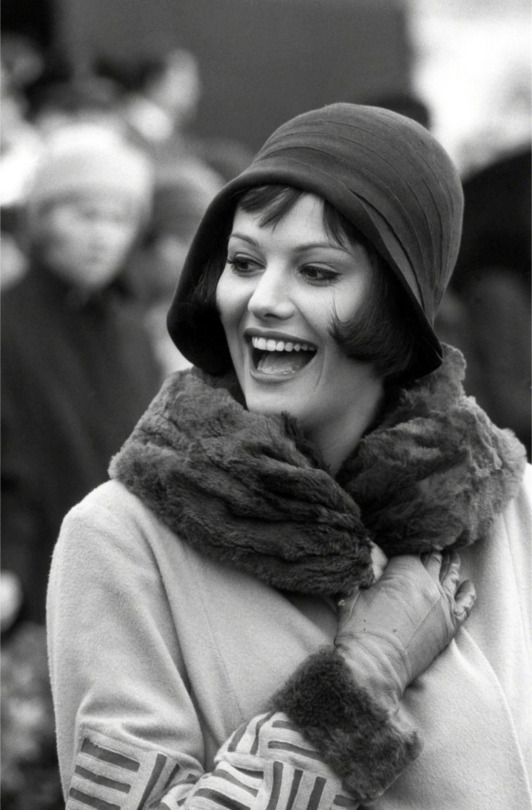
Claudia Cardinale sur un tournage, (Claudia Cardinale on a film set), 1961. Marc Riboud. Silver gelatin print.
#Black and White#Actress#cine#movies#claudia cardinale#photography#photographie#Italy#foto#fotografia#fotografie#mod#pop culture#1960s
112 notes
·
View notes
Text

Moulin Sur Mer, Saint Cyr, Port-au-Prince, Haiti
Claudia Altamimi
16 notes
·
View notes
Text
Consideraciones sobre la República Libre de Fiume

Por Georges Feltin-Tracol
Traducción de Juan Gabriel Caro Rivera
El armisticio del 11 de noviembre de 1918 puso fin a la Gran Guerra, pero no detuvo los combates. Tampoco permitió volver a la época anterior. Los tratados de paz de 1919-1920 impuestos a los vencidos cambiaron el mapa político del continente europeo y dieron lugar a nuevos y violentos conflictos.
En 1974, Dominique Venner publicó Baltikum, una síntesis dirigida al público francés sobre los combatientes alemanes en los Estados bálticos y Silesia. Tres años antes, Jean Mabire había escrito la historia del último general ruso blanco contra el Ejército Rojo, el barón von Ungern-Sternberg. En cambio, no lejos de Francia, la apasionante aventura de Fiume ha estado durante mucho tiempo rodeada de misterio, ya que este golpe de fuerza desconcertó a todos los defensores de la más rígida taxonomía política.
Situado hoy en Croacia con el nombre de Rijeka, en la costa del mar Adriático, el puerto de Fiume se abre al golfo de Carnaro, hoy conocido como bahía de Kvarner. Ciudad pintoresca poblada por italianos, húngaros y eslavos (croatas y eslovenos), antes de 1918 Fiume pertenecía al Imperio de Austria-Hungría, en concreto al Reino de Hungría (o Transleithania), en el que, al igual que los territorios croatas, gozaba de una autonomía especial.
Antes de que Italia entrara en la guerra del lado de la Entente en 1915, desafiando su pasada alianza con los imperios centrales, los nacionalistas italianos ya la reclamaban. Al igual que las vecinas Trentino, Istria y Dalmacia, Fiume era considera como una tierra irredentista. Sin embargo, las negociaciones de paz impuestas por los vencedores, el eje Washington-Londres-París, privaron a Italia de la mayoría de estas reivindicaciones territoriales. Sin embargo, los vencedores no asignaron Fiume al nuevo reino de serbios, croatas y eslovenos (la futura primera Yugoslavia). Como en el caso de Danzig, la ciudad recibió un estatus internacional que no satisfizo a nadie.
El sentimiento de «Victoria mutilada» y la terrible crisis socioeconómica que asoló la Península alimentaron el descontento popular. Los italianos se sintieron repudiados y abandonados por sus recientes aliados occidentales. En un ambiente lleno de tensiones políticas y sociales, el escritor y héroe de guerra Gabriele D'Annunzio (1863-1938) asumió el papel de condottiere.
A la cabeza de un grupo de voluntarios motivados, los «legionarios», D'Annunzio tomó Fiume y sus alrededores el 12 de septiembre de 1919. Fue el comienzo de una larga prueba de fuerza con el gobierno italiano, los Aliados y Belgrado. Criticado por los políticos italianos que desaprobaban su iniciativa militar, Gabriele D'Annunzio proclamó la República Libre de Fiume o Regencia Italiana de Carnaro. Ningún otro Estado reconoció el nuevo Estado. El Fiume se convirtió así en un «Estado fantasma», uno de los primeros de este estilo en el siglo XX. En 2021, todavía existen varios Estados de este tipo en los cinco continentes, como Transnistria, Artsaj, Osetia del Sur-Alania, Abjasia, las Repúblicas Populares del Donbass y, más recientemente, Sealand, la plataforma independiente frente a las costas británicas, y el Principado de Hutt River, en Australia Occidental.
Para sobrevivir al bloqueo impuesto por el ejército italiano, los fiumanos no dudaron en recurrir a un original sistema económico. Claudia Salaris lo denomina «economía pirata». El anarquista estadounidense Hakim Bey, teórico de la Zona Autónoma Temporal (ZAT), asocia sin reparos la experiencia de Fiume a las «utopías piratas» de los siglos XVII y XVIII que estudió bajo su verdadero nombre de Peter Lamborn Wilson. En su opúsculo subversivo, recuerda que las exiguas unidades navales de la república del Danubio tomaron «el nombre de Uscochi de los extintos piratas que vivían en islas de la costa local y asaltaban barcos venecianos y otomanos». Los modernos Uscochi dieron algunos golpes de efecto: ricos barcos mercantes italianos ofrecieron de repente un futuro a la República: ¡dinero en las arcas! Claudia Salaris confirma que «la extraña economía de la Fiume refleja las grandes líneas del antiutilitarismo», el antiutilitarismo que Alain Caillé desarrollaría siete décadas más tarde en Francia en el seno del MAUSS (Mouvement anti-utilitariste dans les sciences sociales).
Gabriele D'Annunzio sabía que Fiume simbolizaba la «nación proletaria oprimida». Creó la Oficina de Relaciones Exteriores, que denunció la Sociedad de Naciones en manos británicas. Esta organización alentó la formación de una Liga de Fiume abierta a todos los pueblos agraviados, ocupados y colonizados. La Regencia italiana de Carnaro apoyó a los alemanes fuera de Alemania, a los irlandeses, a los flamencos, a los malteses, a los egipcios, a los indios, etc. «Esta actitud», señala Claudia Salaris, «prefiguraba con excepcional claridad la idea que abrazaría la generación que crecería en los años sesenta con respecto al Tercer Mundo, los “condenados de la tierra”, frente al imperialismo y la supremacía económica y cultural de Estados Unidos».
Estos sonados golpes militares y diplomáticos no impidieron el fin de la Regencia. El 30 de diciembre de 1920, tras un potente cañoneo de la flota italiana, Gabriele D'Annunzio y sus legionarios abandonaron la ciudad. La ciudad se convirtió en el Estado Libre de Fiume hasta 1924, cuando Italia logró finalmente anexionársela. La «epopeya de Fiume» dejó una huella imborrable. El joven movimiento fascista adoptó el decoro (discursos-diálogos con el público), los símbolos, los eslóganes («¡A nosotros!») y ciertos ritos de los legionarios. Sin embargo, sería un grave error considerar la expedición de Fiume como una repetición de la marcha sobre Roma. Mientras que muchos legionarios se unieron a los arditi con camisas negras, otros adoptaron una decidida postura antifascista.
La ideología de la República Libre de Fiume o Regencia Italiana de Carnaro era, por lo tanto, compleja y, sobre todo, muy heterogénea. En ella influían nacionalistas conservadores, futuros fascistas, veteranos del futurismo, sindicalistas revolucionarios, socialistas intervencionistas, anarquistas, partidarios tempranos del bolchevismo ruso y corporativistas. Sabedor de que el futuro de Fiume descansaba únicamente sobre sus hombros, Gabriele D'Annunzio, que concibió aquí su obra cumbre, demostró ser un poeta clarividente (Vate) y un líder muy deficiente. Encargó a su jefe de gabinete (el equivalente a primer ministro), el sindicalista revolucionario Alceste De Ambris, la redacción de una constitución. Promulgada el 8 de septiembre de 1920, la Carta Carnaro se inspiraba en la antigua Res Publica romana y en las comunas libres italianas de la Edad Media. Representaba un audaz compromiso entre monarquía, aristocracia y democracia. Hombre de la izquierda intervencionista, Alceste De Ambris fue testigo de cómo el propio Vate reescribía gran parte del texto antes de su publicación oficial.
El aspecto monárquico es inequívoco, dada la primacía ejercida por Gabriele D'Annunzio. El texto preveía también la posibilidad de nombrar un «dictador» en caso de crisis grave. Como comandante del Estado, el hombre de letras italiano lo supervisaba todo. Su gobierno constaba de siete ministerios (Guerra, Asuntos Exteriores, Policía y Justicia, Trabajo, Economía, Hacienda y Educación). Llama la atención el carácter democrático del gobierno. Se concede la ciudadanía a todos, incluidas las mujeres, que por fin tienen derecho a votar y a presentarse a las elecciones. El habeas corpus las amparaba en teoría. El Fiume dannunziano era también una democracia directa, basada en la autonomía local y funcional, por un lado, y en el trabajo productivo, por el otro. Es a través de las tareas productivas donde aparece el aspecto aristocrático, una aristocracia del y por el trabajo. Además de un salario mínimo garantizado, el mundo del trabajo se organizaba en nueve gremios (trabajadores industriales y agrícolas, marinos, técnicos industriales y agrícolas, gerentes y directores de empresas privadas, personal administrativo y secretarios privados, profesores y estudiantes, abogados y médicos, funcionarios y trabajadores de cooperativas), mientras que el décimo, informal, reunía a artistas y creadores (¿el propio D'Annunzio?).
¿Cómo funciona este Estado democrático-corporativista o nacional-libertario? El Parlamento tiene dos asambleas:
- el Consejo de los Mejores, elegido por sufragio universal para un mandato de tres años y responsable de los asuntos de soberanía;
- el Consejo de los Gremios, compuesto por sesenta miembros elegidos por los propios gremios para un mandato de dos años, que se ocupa de las cuestiones económicas, el comercio, los asuntos sociales, los servicios públicos, el comercio y los transportes.
Por último, el poder judicial se dividía entre el Tribunal Penal, el Tribunal Civil, el Tribunal Laboral, el Tribunal Municipal y el Tribunal Supremo.
¿No remite este Estado-ciudadano a las instituciones de la república más antigua del mundo, San Marino? Aún vigente en 2021, su constitución data de principios del siglo XVII. La «Serenissima República» tiene un sistema asambleario. Elegido cada cinco años, el Gran y General Consejo nombra cada seis meses a dos Capitanes Regentes, los jefes de la República. Gobiernan con el Congreso de Estado (un gobierno de diez Secretarías de Estado).
Recordamos que en la Carta de Carnaro se dice que «la música es el principio de organización». Gabriele D'Annunzio comprendió instintivamente la importancia de «la música como factor social revolucionario». «La Constitución de Carnaro era mucho más, como le gustaba señalar a D'Annunzio, que un símbolo, un mito, una prefiguración poética e imaginaria de una sociedad futura. Es cierto que nunca tuvo la oportunidad de aplicarse plenamente, ni siquiera en la ciudad de Fiume, pero en el clima de la época representó quizás la síntesis más interesante y siguió siendo un punto de referencia para los especialistas en derecho corporativo y constitucional a lo largo de los años de la Italia fascista primero y democrática después». Recuperada por cierta extrema izquierda, reivindicada por cierta ultraderecha y examinada por algunos partidos no alineados, la breve tentativa política y humana de Fiume sigue siendo, sin embargo, un bello ejemplo de vanguardia política y estética. Más que nunca, es una lección sobre la que merece la pena reflexionar.
2 notes
·
View notes
Text
Animal Crossing memories, part 3
I think this is the final part!
My Joy-Cons haven't completed their journey yet, but in the end I decided that I'm not going to put much faith in them & grabbed a set of used Hori controllers in the meantime. Gave Pan a final tour today. Didn't want to invest in a capture card, so a couple of screenshots is the best I can offer!
Sadly there's no way in heck I can stuff all of them into a single post, so I'll just narrow it down to my favourites & the ones I have something to say about!

First, the map. My villagers were Gruff the goat, Kitt the kangaroo, Sprinkle the penguin, Kyle the wolf, Ione the squirrel, Olaf the anteater, Al the gorilla, Jambette the frog, Fang the wolf and Fuchsia the deer. I liked them all, fuglies included. I like a lot of the ugly ones now!

Naturally my biggest dream was to invite Shrek to the island. Shrek never showed up. I had to resort to home-brew methods!

Frample's home. I couldn't fit the big-ass yard in the frame, but there was a little islet with a snapping turtle living on it. A homage to Jacksepticeye's Tortellini, forever jammin'!

The Zen Garden that my villagers never really cared for, haha. I found out they aren't very eager to interact with any objects that aren't close to their houses or the plaza. They sometimes goof around on the southern beaches, but that's pretty much it!

(At least those lads were having a time of their life)
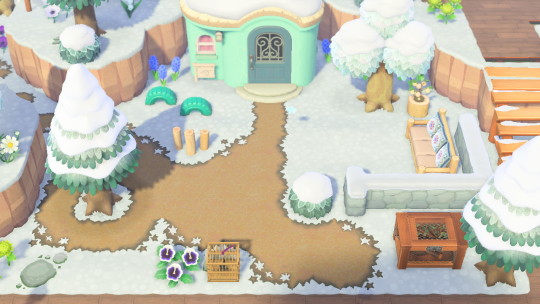
Ione's yard was the bane of my existence - the laggiest part of the island. I was never able to pinpoint the cause, there was no water and not even that much foliage. Some folks say that snow causes the game to get quite choppy, but it lagged during the other seasons too. Maybe it was all the custom paths?

Sprinkle lived close to Ione. Her yard was a bit more spacious, so I could build Snowboys there. Some of them still ended up in the river!

The main road with 5 frickin' waterfalls. Not visible here, but there was another one on the left. A good place to be if you want your eardrums to explode!

This cliff served no particular purpose, but I liked the view! This was my stargazing hideaway.

The campsite was pretty dang huge and placed right next to the island entrance. A decision I came to regret after some time. Now I prefer them tucked away in a secluded spot!
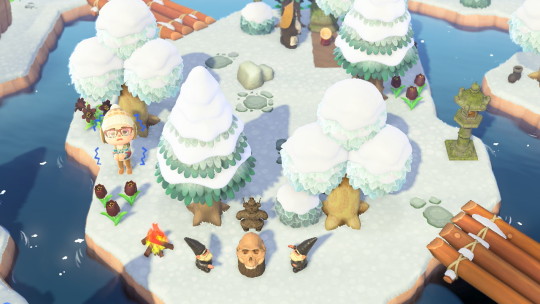
Isle of Spooks! My villagers never visited it except for that single time when Gruff decided to sneak in and investigate. Gruff was an absolute legend.
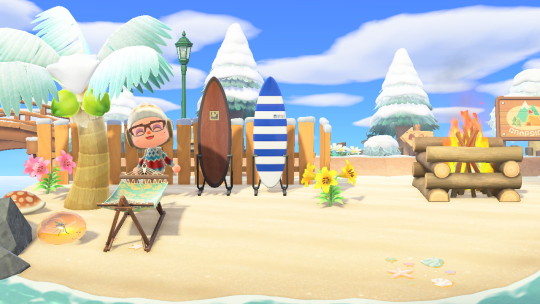
The beach next to the campsite was one of the few decorated beach areas that I was actually quite happy with!
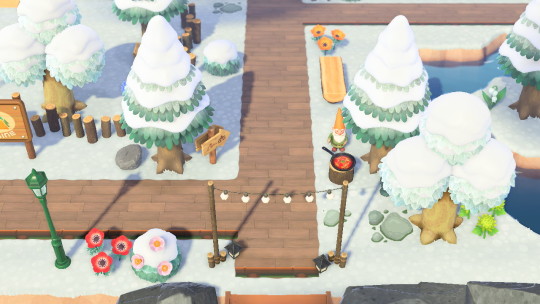
The entrance. Nothing too fancy, but there were so many failed attempts at making a decent entrance, lmao. Makes ya finally settle with whatever ya have!

Kitt's yard! I remember feeling very proud of it once, but it doesn't really appeal to me anymore, especially that blob of a path.

Farmlands. That rainbow flower garden was a convenient way of keeping most of the flower breeds & colours in one spot, without them overtaking an entire island, but probably not something I'd build today. I hated when balloons flew over it because I couldn't shoot them down from there!

This yard was between the farms. First it was Tasha's, then Claudia's, then Fang's. I never bothered to redecorate, haha.

And here were the crops. Leif has failed me & never brought the carrots!

The woods behind the farms. (Wayyy too much clutter for my current tastes, but at least my main man Gruff was there)

The pirate bay! One of my oldest builds, but still very much up my alley!

(What if I told you that Pompom never really moved away?)

Alrighty, that's most of the western side of Pan covered. Here's a land bridge that connected the main cliffs behind the plaza. Waterscaping around it was absolute hell! Admittedly, I'm still quite proud of it & it's something I'd like to build again, but most likely without the dang river.

The road leading up to the Museum. Museum was an important building for me because of my first job, but I never quite got the surrounding area to look right. I do like the stone lion-dog statues, though!

Jambette's yard was my absolute favourite spot on the entire island. Minimalism was the name of the game. With a frog model from Jim!

Kyle's yard had a bit of a side business in the top left corner!

Eastern river mouth. I was all about putting those little islets on my rivers and lakes. It's fun and games till a special character or a fossil decides to spawn on them..!

Moving back to the eastern cliffs: here are some hungry gnomes and Olaf's yard. I always gifted all of my dresses as well as dumbest pieces of furniture to Olaf. He took it all like a champ!

I gave Mr. Resetti an extra job on Pan. (And a lazy bear compadre)
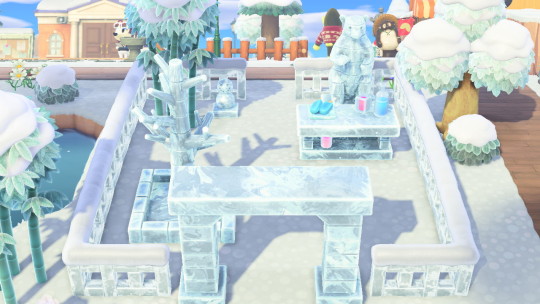
A seasonal icy drink bar - with Al's ass cheeks in the background for everyone's viewing pleasure. Al was the very first villager I found on a mystery island on a rainy day. Seeing his silhouette in the rain, I legit thought he was some kind of zombie. I didn't invite him back then, but when I bumped into him again on my last villager hunt, I decided to take him. Mad lad has finally made it!

Fuchsia's yard. A bit funky, but I still like it!
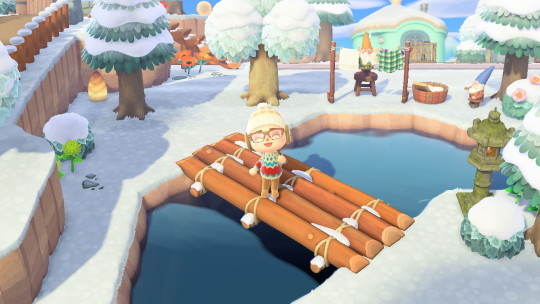
And that's it! There's a bunch of other screenshots I wasn't able to fit in, like the absolutely glorious board drawings from my best friends. Don't worry though, they are safe and sound with me! Farewell, Pan. You were my introduction to Animal Crossing and even though I'm ready to move on, I will always remember you very fondly!
7 notes
·
View notes
Text
Ce qu'un enfant ferait pour ses parents


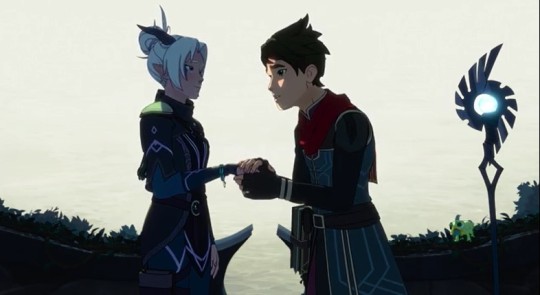
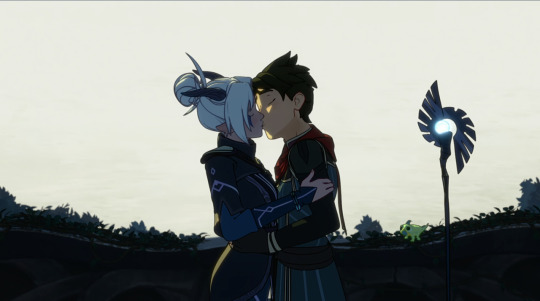

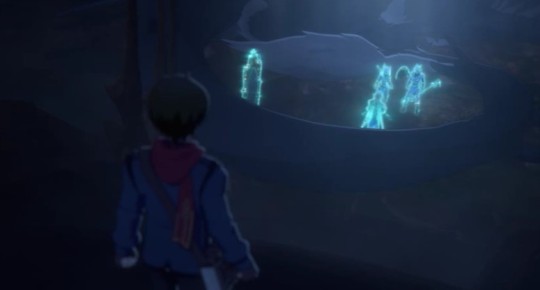
Lors de l'épisode 8 de la saison 3, Rayla décide de rester à la flèche de tempête pour payer le prix de la faute de ses parents et Callum voit sa raison de rester comme une fierté. Dans l'épisode 9 de la saison 6, Callum a fait un bracelet de phoenix de lune pour qu'elle puisse revenir dans le monde des vivants. Dans le nid de Zubeia, Callum a utilisé un sort de lune pour connaître la vérité sur ce qui s'est passé ! C'est grâce cette information que Rayla a pu dire que c'est grâce à ses parents que l'oeuf est en sécurité et qu'ils ont pu le ramener à sa mère. Malheureusement, elle se sépare d'eux et bien que ça lui brise le coeur. Ses parents comprennent mais ils savent qu'elle aura une bonne vie. Ce qui contraste avec Claudia qui retrouve Viren car elle a besoin qu'elle lui montre le bon chemin, que c'est grâce lui, qu'elle a pu se construire. Mais Terry essaie de la raisonner car un mort ne peut pas donner de réponses. Viren était son phare qui s'est éteint dans les flammes.

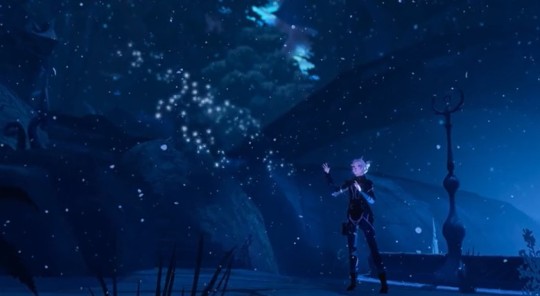


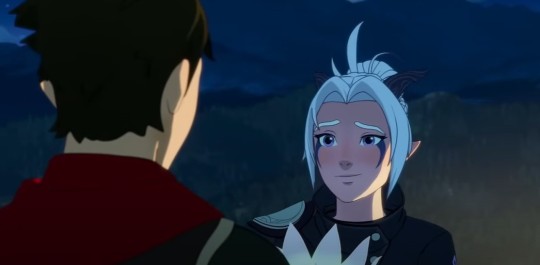

Rayla décide de sauver Runaan lui rappelant qui il était, l'assassin mais aussi le père qui l'a élevée. Et par son amour et celui d'Ethari, elle le ramène dans le monde des vivants auprès de Callum. Tandis que Claudia en apprenant le passé d'un père aimant sa défunte fille. Cela lui permet de retrouver l'amour nécessaire, celui malsain et auto destructeur, pour exécuter le sort. Encore une fois leurs amours envers leurs parents se confrontent à nouveau (J'en parle plus ici). Rayla peut enfin tourner la page concernant ses parents. Elle avait quitté Callum pour traquer Viren, qualifiant même de vengeance dans la saison 4 pour avoir des réponses concernant sa famille. Alors que Claudia qui voit son modèle détruit, elle trouve du réconfort avec Aaravos en sympathisant avec sa peine. Quand à Terry, il trouve que cette histoire d'amour est devenu tordu par la suite. Aaravos la manipule en choisissant les bons mots pour décrire Leola mais aussi Viren. Il le qualifie d'un père aimant, un grand homme qui était prêt à tout sacrifié quitte à être mal compris. Ce qui se complète avec la phrase "peu importe si c'est ignoble ou dangereux".
En parlant avec mon ami, il trouve qu'il y a un contraste entre ces deux là, sur comment elles gèrent leurs deuils :
Claudia a longtemps été dans le déni en étant obsédé de ressusciter son père que quand ce dernier voit toute les erreurs qu’il a faite et qu'il décide d’en subir les conséquences, dans la paranoïa, sa fille croit que tout le monde l’abandonne pour au final essayer d’accepter la vérité.
Rayla se résigne à la mort de ses parents au début car elle les voyait comme des traîtres. Avant que Claudia lui donne les pièces deux ans plus tard pour qu'au final elle accepte qu'ils se soient sacrifiés en héros. Ramener ses parents aurait été égoïste de la part de Rayla, alors qu'Ethari attend toujours le retour de Runnan. Donc au final c’est Claudia qui a agit par égoïsme et Rayla par abnégation.
What would a child do for their parents
In episode 8 of season 3, Rayla decides to stay at the storm spire to pay the price for her parents' wrongdoing, and Callum sees her reason for staying as pride. In episode 9 of season 6, Callum made a moon phoenix bracelet so she could return to the world of the living. In Zubeia's nest, Callum used a moon spell to learn the truth about what happened! With this information, Rayla was able to say that it was thanks to her parents that the egg was safe and that they were able to return it to his mother. Unfortunately, she's parting ways with them and although it breaks her heart. Her parents understand, but they know she'll have a good life. This contrasts with Claudia, who finds Viren because she needs him to show her the right path, that it's thanks to him that she's been able to build herself. But Terry tries to reason with her, because a dead man can't give answers. Viren was her lighthouse, which was consumed by flames.
Rayla decides to save Runaan, reminding him of who he was, the murderer but also the father who raised her. And through her love and that of Ethari, she brings him back to the world of the living, back to Callum. Claudia, on the other hand, learns of the past of a father who loved his deceased daughter. This allows her to regain the love she needs - the unhealthy, self-destructive love - to carry out the spell. Once again, their love for their parents collides (more on that here). Rayla can finally turn the page on her parents. She had left Callum to track down Viren, even calling it vengeance in season 4 to get answers about her family. While Claudia sees her role model destroyed, she finds comfort in Aaravos, sympathizing with his grief. As for Terry, he finds the love affair twisted in the aftermath. Aaravos manipulates her by choosing the right words to describe both Leola and Viren. He calls him a loving father, a great man who was ready to sacrifice everything even if it meant being misunderstood. This is complemented by the phrase “no matter how vile or dangerous”.
Talking with my friend, he finds that there's a contrast between the two of them, in terms of how they deal with grief:
Claudia has long been in denial, obsessed with bringing her father back to life, but when he sees all the mistakes he's made and decides to face the consequences, in paranoia, her daughter believes that everyone has abandoned her, and finally tries to accept the truth.
Rayla resigns herself to her parents' death at first, seeing them as traitors. Then, two years later, Claudia gives her the coins, and she finally accepts that they sacrificed themselves as heroes. Bringing back her parents would have been selfish on Rayla's part, while Ethari is still waiting for Runnan's return. So in the end it was Claudia who acted out of selfishness and Rayla out of self-sacrifice.
#the dragon prince#tdp#tdp s6#tdp s6 spoilers#tdp analysis#analysis#rayla#runaan#lain#tiadrin#claudia#viren#aaravos
18 notes
·
View notes